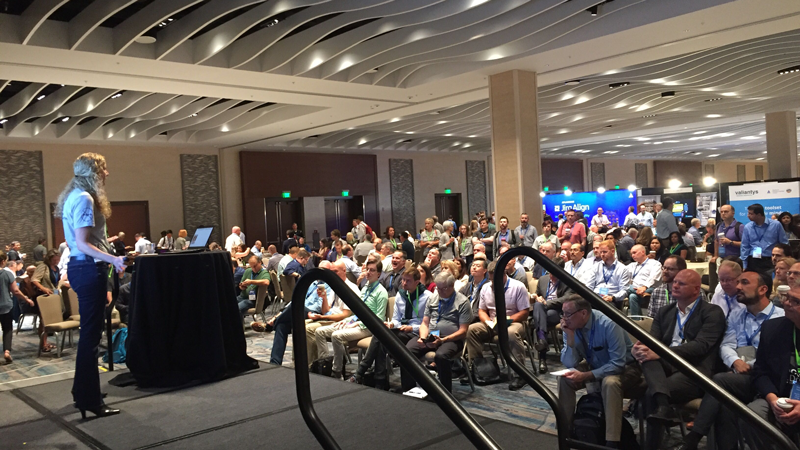
In a previous blog, “Agile Release Trains are Key to Scaling Output,” I reviewed how Agile release trains (made up of multiple Agile teams) are the key to Agile at scale. Building successful teams is a good first step, but alignment across teams doesn’t just happen—it takes an ongoing commitment from Agile leaders. Agile ceremonies represent one clear way for leaders to ensure macro alignment across teams. In this post, we’ll look at some of the practices and components of Agile ceremonies to help achieve alignment.
Successful Agile teams need to be autonomous; they also need to be collaborative entities characterized by team stability. That stability means contributing team members prosper and grow by working with cross-functional teams and being exposed to different functions outside of their area of expertise. All those things depend on effective leadership at the Agile team level (Scrum Master and Product Owner) and at the Agile Release Train (ART) level (Release Train Engineers and Product Management).

If you think all this places a lot of responsibility on leadership (at all levels), you’re right. So, how can Agile team leaders and ART leaders work to achieve stability and consistency at the Agile team level while also ensuring collaboration at the ART level? Let’s examine some of the tools team leaders can use to be successful.
For development teams, sound practices, including concepts like regular code reviews, optimal task branching when necessary, and continuous team integration, all have their place when working toward efficient production of frequent and predictable releases. Check out this video: How to Measure at the Teams of Teams Level for further suggestions on tracking the health metrics.
But practices alone will only get you so far. Delivering value also requires ongoing organizational discipline. Clearly defined Agile ceremonies go even further to help build team and ART accountability and more importantly, alignment. Agile leaders can get their teams to the “Performing” stage of Tuckman’s Stages of Team Development faster by facilitating structured ceremonies to create collaboration. Here’s some components of Agile ceremonies worth understanding:
Stand-Ups
Many sprint-based cadences depend on frequent stand-ups, usually daily. These are vital to tracking progress and surfacing any obstacles slowing team output. For Scrum teams, stand-ups usually center around the following questions:
- What did you finish/work on yesterday?
- What are you working on today?
- Do you have any blocks?
Backlog Grooming
Backlog grooming happens when a product owner and development (or non-dev) team examines the backlog to prioritize where teams should focus next. It’s here where unplanned work or deliverables are either discarded or prioritized if it’s determined more important than existing work. Scrum teams commonly handle all backlog grooming during cadenced ceremonies. Kanban teams, on the other hand, handle it in smaller increments.
Incremental Delivery
Agile helps teams focus on incremental delivery over short cycles. Scrum teams call these cycles Sprints. Conversely, Kanban teams focus on their cycle times, which is the time it takes for them to deliver an increment of value. Kanban teams continuously look for ways to reduce that cycle time.
Sprint Planning
This is usually a two-hour planning session for Scrum teams. This planning phase represents the time teams can prioritize work and to review the deliverables required for the team to hit their output goals. Before they can do any of this effectively, teams need a clearly defined backlog.
Retrospectives
Retrospectives are meetings where Agile teams will review or re-visit past outputs. Think of them like a post-mortem meeting with structure. Scrum teams usually center these around three questions: 1) what worked well? 2) What didn’t? And 3) how can this be more effective in the future? Kanban teams bring results from the board, ready to discuss active ways those things can be improved.
Demos
Demos are one of the most vital Ceremonies, since they provide teams the opportunity to get direct feedback from customers and stakeholders. Much like many other Ceremony components, demos happen on a regular cadence. Information derived from demos is critical since it helps teams understand pain points, feature requests, and issues that need to be fixed. In other words, clear indications for what needs to be prioritized for future delivery from the ART.
Program Implement (PI) and Mid-Range Planning
If you’re using Scaled Agile Framework (SAFe®) you know this stage as Program Implement Planning or PI Planning. Otherwise, it’s commonly known as Quarterly or Mid-Range Planning. It typically occurs between the Strategic Planning phase that precedes most big projects and the Team Delivery phase. Length of time can vary, but PI Planning usually takes place over two days and cadence-wise, typically happens every eight to twelve weeks. PI Planning is the time to align the strategic goals and propose epics to the ARTs collective capacity for the next program increment. It’s during PI planning that the Agile Release Trains and teams within the release train commit to their work over the next 8 to 12 weeks. The PI or Quarterly Planning meeting serves as an interlock point for the release train teams to get alignment from the portfolio and strategic plan, but also voice concerns based on team dependencies or risks that might stall progress during the next work period. Most importantly, PI Planning is the time for Agile leaders to ensure alignment, coordination, and prioritization of work across all Agile teams with the release trains.
If you’re interested in learning more, download our eBook “Get on Board: Building High-Performance Agile Teams.” In it, we’ll take a deeper dive into the ceremonies presented on this topic and provide recommendations on how to get started.





